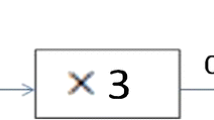Abstract
There has been a variety of approaches to the study of mathematical understanding, and some of these are reviewed before outlining the background to the model we are proposing for the growth of such understanding. The model is explained in detail and illustrated with reference to the concept of fractions. Key features of the model include ‘don't need’ boundaries, ‘folding back’, and the complementarities of ‘acting’ and ‘expressing’ that occur at each level of understanding. The theory is illustrated by examples of pupils' work from a variety of topics and stages. Finally one of the practical applications of the theory, mapping, is explained in some detail.
Similar content being viewed by others
References
Bauersfeld, H.: 1988, ‘Interaction, construction, and knowledge: Alternative perspectives for mathematical education’, in Effective Mathematics Teaching, NCTM, pp. 27–46.
Einstein, A. (as quoted in Fine, A.): 1986, The Shakey Game — Einstein, Realism and the Quantum Theory, Chicago, University of Chicago Press, p. 91.
Hadamard, J.: 1945, The Psychology of Invention in the Mathematical Field, Princeton University Press.
Herscovics, N. and Bergeron, J.: 1988, ‘An extended model of understanding’, in C. Lacompagne and M. Behr (eds.), Proceedings of PME-NA 10, Dekalb, Ill: Northern Illinois University, pp; 15–22.
Kieren, T. E.: 1990, ‘Understanding for teaching for understanding’, The Alberta Journal of Educational Research36(3), 191–201.
Kieren, T. E. and Pirie, S. E. B.: 1992, ‘Rational and fractional numbers: From quotient fields to recursive understanding’, in T. P. Carpenter and E. Fennema (eds.), Learning, Teaching, and Asessing Rational Number Concepts: Multiple Research Perspectives, Lawrence Erlbaum Associates, Hillsdale, N.J., pp. 49–82.
Kieren, T. E. and Pirie, S. E. B.: 1991, ‘Recursion and the mathematical experience’, in L. Steffe (ed.), The Epistemology of Mathematical Experience, Springer Verlag Psychology Series, New York, pp. 78–101.
Kieren, T. E. and Pirie, S. E. B.: 1992, ‘The answer determines the question — Interventions and the growth of mathematical understanding’, in Proceedings of Sixteenth Psychology of Mathematical Education Conference (New Hampshire), Vol. 2, pp. 1–8.
Kieren, T. E. and Pirie, S. E. B.: in press, ‘Folding back: A dynamic recursive theory of mathematical understanding’, in D. Sawada and M. Caley (eds.), Recursion in Educational Enquiry, Gordon and Bream, New York.
Maturana, H. R. and Varela, J. F.: 1980, Autopoeisis and Cognition, Boston University, Philosophy of Science Series, Vol. 42, D. Reidel, Dordrecht.
Maturana, H. R. and Varela, J. F.: 1987, The Tree of Knowledge, The New Sciences Library, Shambhala, Boston.
Ohlsson, S.: 1988, ‘Mathematical meaning and applicational meaning in the semantics of fractions and related concepts’, in J. Hiebert and M. Behr (eds.), Number Concepts and Operations in the Middle Grades, NCTM/LEA, Reston, pp. 53–91.
Pirie, S. E. B.: 1988, ‘Understanding — Instrumental, relational, formal, intuitive..., How can we know?’, For the Learning of Mathematics8(3), 2–6.
Pirie, S. E. B. and Kieren, T. E.: 1989a, ‘Through the recursive eye: Mathematical understanding as a dynamic phenomenon’, in G. Vergnaud (ed.), Actes de la Conference Internationale, PME, Vol. 3, Paris, pp. 119–126.
Pirie, S. E. B. and Kieren, T. E.: 1989b, ‘A recursive theory of mathematical understanding’, For the Learning of Mathematics9(3), 7–11.
Pirie, S. E. B. and Newman, C. F.: 1990, ‘Watching understanding grow’, paper presented at the Midlands Mathematics Education Seminar, University of Birmingham.
Pirie, S. E. B. and Kieren, T. E.: 1990, ‘A recursive theory for mathematical understanding — some elements and implications’, paper presented at AERA annual meeting, Boston.
Pirie, S. E. B. and Kieren, T. E.: 1991, ‘Folding back: Dynamics in the growth of mathematical understanding’, in F. Furinghetti (ed.), Proceedings Fifteenth Psychology of Mathematics Education Conference, Assisi.
Pirie, S. E. B. and Kieren, T. E.: 1992a, ‘Watching Sandy's understanding grow’, The Journal of Mathematical Behaviour11(3), 243–257.
Pirie, S. E. B. and Kieren, T. E.: 1992b, ‘Creating constructivist environments and constructing creative mathematics’, special edition, in E. von Glasersfeld (ed.), Educational Studies in Mathematics23(5), 505–528.
Schroder, T. L.: 1987, ‘Students' understanding of mathematics: A review and synthesis of some recent research’, in J. Bergeron, N. Herscovics, and C. Kieran (eds.), Psychology of Mathematics Education XI, PME, Montreal, Vol. 3, pp. 332–338.
Serpinska, A.: 1990, ‘Some remarks on understanding in mathematics’, For the Learning of Mathematics10(3), 24–36.
Skemp, R. R.: 1976, ‘Relational understanding and instrumental understanding’, Mathematics Teaching77, 20–26.
Skemp, R. R.: 1987, The Psychology of Learning Mathematics (expanded edition), Lawrence Erlbaum Associates, Hillsdale, N.J.
Tomm, K.: 1989, Consciousness and Intentionality in the Work of Humberto Maturana, a presentation for the Faculty of Education, University of Alberta.
von Glasersfeld, E.: 1987, ‘Learning as a constructive activity, in C. Janvier (ed.), Problems of Representation in the Learning and Teaching of Mathematics, Lawrence Erlbaum Associates, Hillsdale, N.J., pp. 3–18.
Author information
Authors and Affiliations
Rights and permissions
About this article
Cite this article
Pirie, S., Kieren, T. Growth in mathematical understanding: How can we characterise it and how can we represent it?. Educ Stud Math 26, 165–190 (1994). https://doi.org/10.1007/BF01273662
Published:
Issue Date:
DOI: https://doi.org/10.1007/BF01273662




